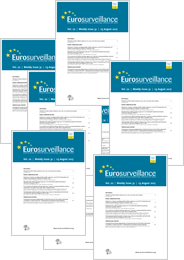- Home
- Weekly releases (1997–2007)
- Previous Issues
- Volume 6, Issue 47, 21/Nov/2002
Weekly releases (1997–2007) - Volume 6, Issue 47, 21 November 2002
Volume 6, Issue 47, 2002
- Articles
-
-
-
European travellers affected by the outbreak of Plasmodium vivax malaria in Northern Queensland, Australia
More LessAn outbreak of Plasmodium vivax malaria at a campsite in Northern Queensland has affected 10 people including three overseas visitors (one from Ireland, one from Germany, and one from Canada). The outbreak occurred during the first two weeks of October 2002 in tourists staying at the Noah Beach campsite, which is a campsite in Daintree National Park, Cape Tribulation. Park rangers have used details from self-registration forms at the campsite to compile a list of visitors to Noah Beach during the period of malaria transmission. Where contact details were available, the Tropical Public Health Unit in Queensland contacted individuals to inform them of the occurrence of malaria and offer advice. Visitors to the park have included travellers from the United Kingdom, Switzerland, Italy, Israel, the Netherlands, and Sweden (Dianne Brookes ([email protected]), Tropical Public Health Unit, Queensland, personal communication, 12 November 2002).
-
-
-
Pertussis and pertussis prophylaxis in Denmark
More LessIn Denmark, pertussis is notifiable in children aged <2 years (the age group at which pertussis is considered potentially dangerous), when the child has clinical whooping cough which is laboratory confirmed. In 2001, there were 196 notifications in children: 95 boys and 101 girls (1). This is marginally higher than in 1999 and 2000, when there were 166 and 178 cases respectively (2, 3). In 66% of cases, the Statens Serum Institut’s department of epidemiology had to remind the clinician to submit a notification form. A total of 80 children (41%) were aged <3 months, 119 children (61%) were <5 months and 161 children (82%) were <1 year. Between three and 38 cases per month were notified, most of them in the second half of the year. The total annual incidence for children <2 years was 146 per 100 000. Most of the notified cases (72%) were confirmed by polymerase chain reaction (PCR) alone, while 28% were confirmed by culture with or without positive PCR.
-
-
-
Results from laboratory-based reporting of syphilis in Germany, 2001-2002
More LessFrom the beginning of 2001 to mid-2002, 2783 cases of syphilis were notified to the Robert Koch-Institut (RKI) in Germany (1). Of these notifications, 1681 were for cases diagnosed in 2001, and 1102 were for cases diagnosed so far in the first half of 2002 (a 50% increase on the first half of 2001). The annual number of syphilis notifications in Germany between 1995 and 2000 was between 1120 and 1150. The recent rise in reported cases follows a major change in the German syphilis notification system, from physician- to laboratory-based reporting, which was introduced at the beginning of 2001.
-
-
-
New issue of EpiNorth online
More LessThe latest issue of EpiNorth (volume 3, number 3), the bulletin of the network for infectious disease control in the Barents and Baltic Sea Region, is now available online at www.epinorth.org
-
-
-
Possible rabies-like infection in Scotland
More LessA man has been admitted to hospital in Scotland with an acute neurological illness that is being investigated as a suspected case of rabies (1,2). The possible diagnosis of a rabies-like illness is being considered because of some aspects of the clinical presentation and because the man is a bat handler who has been bitten by a bat in Scotland on at least one occasion within the possible incubation period for rabies. There is no documented evidence that the patient has ever received rabies immunisation or has travelled abroad since 1996. Although the clinical features of the man's illness are compatible with some aspects of rabies, none of the laboratory investigations yet indicate that a rabies-like virus is responsible. Testing for rabies and rabies-like virus is not, however, straightforward and more tests are being undertaken. The case has raised awareness of the possibility of rabies-like virus infection of bats in the United Kingdom (UK) (3).
-
-
-
Diagnosis of lyssavirus infection confirmed in case of human rabies in Scotland - updated 25 November
More LessLaboratory results of tests on the case of suspected rabies in Tayside, Scotland, have shown that the man was infected with a European bat lyssavirus (EBL) (1). Further results on the type of EBL are awaited. The patient died on 24 November 2002 (2).
-
-
Most Read This Month

-
-
Chikungunya in north-eastern Italy: a summing up of the outbreak
R Angelini , A C Finarelli , P Angelini , C Po , K Petropulacos , G Silvi , P Macini , C Fortuna , G Venturi , F Magurano , C Fiorentini , A Marchi , E Benedetti , P Bucci , S Boros , R Romi , G Majori , M G Ciufolini , L Nicoletti , G Rezza and A Cassone
-
- More Less


